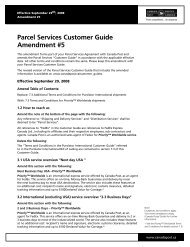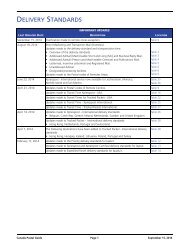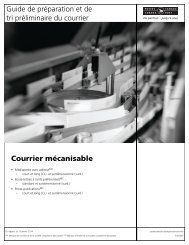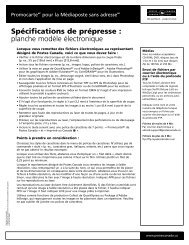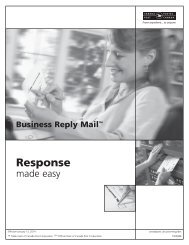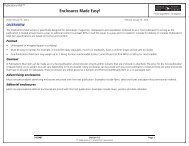Download as PDF - Canada Post
Download as PDF - Canada Post
Download as PDF - Canada Post
Create successful ePaper yourself
Turn your PDF publications into a flip-book with our unique Google optimized e-Paper software.
Brisebois came to Peller from the financial services sector, which<br />
combs through reams of consumer data to craft highly targeted,<br />
relevant DM campaigns. “Your bank probably knows more about<br />
you than your mother,” she jokes. “I know where to get a hold of<br />
you, I know if you’ve got money to spare that you might be interested<br />
in a GIC with a great rate of return.”<br />
Working in tandem with <strong>Canada</strong> <strong>Post</strong>, Brisebois says that DM<br />
agencies are becoming incre<strong>as</strong>ingly proficient at doing unaddressed<br />
drops in what she calls a “fairly targeted” manner. One recent<br />
Peller campaign for a female-targeted wine, for example, successfully<br />
targeted neighbourhoods that over-indexed against females of a<br />
certain age.<br />
“You can target income level, age levels, multi-people households<br />
using Geo<strong>Post</strong> Plus, a <strong>Canada</strong> <strong>Post</strong> targeting tool, and then overlay<br />
psychographic [information] to refine that data b<strong>as</strong>ed on consumer<br />
insights, BBM media usage, new segmentation tools, technographic<br />
profiles,” says Percy-Dove. “The tools available to really hone in on<br />
a specific target via unaddressed ad mail are very powerful now.”<br />
While targeting is vital to creating campaigns that work, clean<br />
data lies at the heart of any successful marketing datab<strong>as</strong>e, and<br />
without it the costs to businesses extend far beyond production spend<br />
per DM piece. Over 140,000,000 items of mail are either sent to<br />
incorrect recipients or inaccurate addresses each year. In addition,<br />
customers are switched when their names are misspelled, and sending<br />
multiple copies of the same piece to the same household is not only<br />
bad for the bottom line, but also damages the brand by giving it an<br />
air of laziness. Fortunately, marketers are clueing in on the importance<br />
of accurate data, and are <strong>as</strong>sisted by tools, which allow them to<br />
clean and update their customer and prospect mailing lists.<br />
As always in the marketing realm, knowledge is power. Asked to<br />
theorize how the direct industry might look a decade from now,<br />
Wunderman’s Mark Russell responds that he sees clients “needing<br />
to embrace that they can me<strong>as</strong>ure a heck of a lot more than they<br />
ever could, and they need to start me<strong>as</strong>uring it, create insights<br />
from it, and market back to their customers in a more personable,<br />
personalized way.”<br />
Russell says that DM’s previously utilitarian approach to customer<br />
engagement h<strong>as</strong> been forever altered by what is occurring in the social<br />
media space. “If you have a communication platform like [longtime<br />
Wunderman client] Ford does that’s socially b<strong>as</strong>ed, then all of the<br />
channels have to adapt to meet the demand of the social platform<br />
and how we communicate,” he says.<br />
Throughout its history, DM h<strong>as</strong> proven remarkably versatile in<br />
how it adapts to both changes in technology and marketing approaches.<br />
In short, <strong>as</strong> long <strong>as</strong> there are mailboxes, there will be DM.<br />
DM EVOLVED:<br />
TECHNOLOGY IN THE MAIL<br />
Today’s marketing world is incre<strong>as</strong>ingly split into two camps:<br />
digital and everything else. Each side h<strong>as</strong> its adherents. Traditional<br />
media proponents praise its ability to create an emotional connection<br />
with consumers; digital media practitioners espouse their discipline’s<br />
me<strong>as</strong>urability and hyper-targeting capabilities. An ideal solution<br />
would bridge the divide, combining the benefits of both the physical<br />
and digital, and savvy businesses have realized that with incre<strong>as</strong>ed<br />
integration this h<strong>as</strong> been made possible. Here are three technologies<br />
that companies are using to deliver success:<br />
Web Keys<br />
These devices have the appearance of a traditional mailer but<br />
feature a USB connector that pops out of the side of a package like<br />
a pocketknife. When inserted into a computer, the device takes<br />
users to a customized web page capable of conveying everything<br />
from additional product information and benefits to exclusive<br />
offers. Unique codes in each key allow marketers to determine<br />
which recipients are inserting the webkey into a computer, how<br />
long they engage with a site, and even how many times they use<br />
the device.<br />
QR Codes<br />
An excellent example of how direct mail campaigns can support online<br />
efforts, these images can be scanned with smartphones, directing<br />
users to company websites, where they can access more information.<br />
They also add an extra dimension to the me<strong>as</strong>urability of a DM piece<br />
because it’s e<strong>as</strong>y to track how many recipients scan the QR code<br />
and land on the website. Requiring only a smartphone and free<br />
scanning application, they showc<strong>as</strong>e the seamless integration possible<br />
between physical and digital.<br />
Audio Chips<br />
Not just for greeting cards anymore, audio files can now be customized<br />
to target segments and even individual customers. A huge improvement<br />
in technology h<strong>as</strong> delivered a crisp sound worthy of any pitch.<br />
2011 edition I 13




